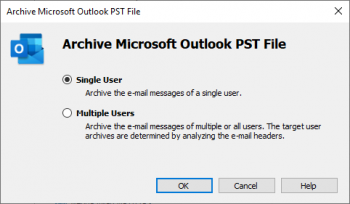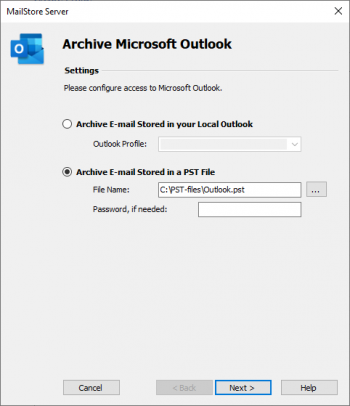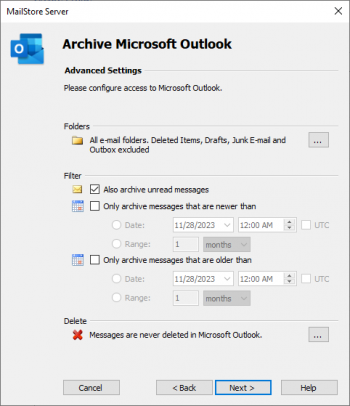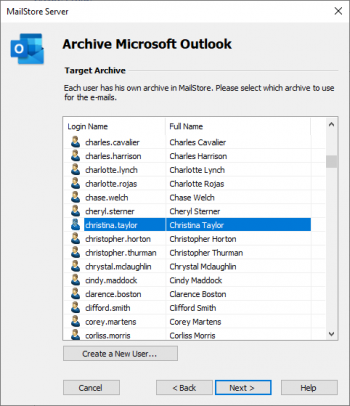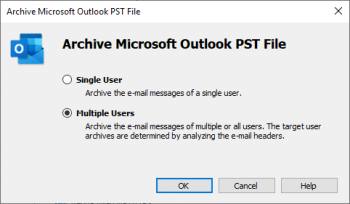Difference between revisions of "Archiving Outlook PST Files Directly"
| [unchecked revision] | [checked revision] |
| (6 intermediate revisions by 3 users not shown) | |||
| Line 1: | Line 1: | ||
| − | |||
| − | |||
| − | |||
| − | |||
With MailStore Server, PST files can be archived directly. Contrary to archiving emails from Outlook, here you can create and execute archiving tasks independently from users and user computers. The users' individual PST files should be made available centrally, e.g. through a network share. | With MailStore Server, PST files can be archived directly. Contrary to archiving emails from Outlook, here you can create and execute archiving tasks independently from users and user computers. The users' individual PST files should be made available centrally, e.g. through a network share. | ||
<p class="msnote">'''Please note:''' The computer used for archiving PST files through the MailStore Client must have a version of Outlook installed that is compatible with the PST files selected. For example, to archive an Outlook 2007 PST file, the corresponding version of Outlook needs to be installed.</p> | <p class="msnote">'''Please note:''' The computer used for archiving PST files through the MailStore Client must have a version of Outlook installed that is compatible with the PST files selected. For example, to archive an Outlook 2007 PST file, the corresponding version of Outlook needs to be installed.</p> | ||
| + | |||
| + | <p class=msnote>'''Please note:''' If you work with an Outlook/Exchange environment, you get better results by first opening the existing PST file in Outlook and then using the ''Archive Email Stored in your Local Outlook'' option. This way you can ensure that all existing sender and recipient addresses are correctly archived.</p> | ||
Setting up archiving processes for PST files is done using archiving profiles. General information about archiving profiles is available in the chapter [[Email_Archiving_with_MailStore_Basics#Working_with_Archiving_Profiles|Working with Archiving Profiles]]. | Setting up archiving processes for PST files is done using archiving profiles. General information about archiving profiles is available in the chapter [[Email_Archiving_with_MailStore_Basics#Working_with_Archiving_Profiles|Working with Archiving Profiles]]. | ||
| − | = Archiving a PST file that contains emails of a single user = | + | == Archiving a PST file that contains emails of a single user == |
| − | |||
<p class="msnote">'''Please note:''' If you don't want to archive PST files in your personal user archive only, you'll have to be logged on to MailStore Client as a MailStore Server administrator. Only a MailStore Server administrator can archive emails for other users.</p> | <p class="msnote">'''Please note:''' If you don't want to archive PST files in your personal user archive only, you'll have to be logged on to MailStore Client as a MailStore Server administrator. Only a MailStore Server administrator can archive emails for other users.</p> | ||
| Line 23: | Line 20: | ||
*: [[File:arch_pst_01.png|center|350px]] | *: [[File:arch_pst_01.png|center|350px]] | ||
*Select ''Archive Email Stored in a PST File'' as source and specify the PST file to be archived. Click on ''Next''. | *Select ''Archive Email Stored in a PST File'' as source and specify the PST file to be archived. Click on ''Next''. | ||
| − | |||
*If needed, adjust the settings for the [[Email_Archiving_with_MailStore_Basics#Archiving_Specific_Folders|List of Folders to be Archived]], the filter and the [[Email_Archiving_with_MailStore_Basics#Archiving_Specific_Folders|Deletion Rules]]. | *If needed, adjust the settings for the [[Email_Archiving_with_MailStore_Basics#Archiving_Specific_Folders|List of Folders to be Archived]], the filter and the [[Email_Archiving_with_MailStore_Basics#Archiving_Specific_Folders|Deletion Rules]]. | ||
*: [[File:arch_pst_02.png|center|350px]] | *: [[File:arch_pst_02.png|center|350px]] | ||
| Line 30: | Line 26: | ||
*In the final step you can specify a name for the new archiving profile. After clicking on ''Finish'', the archiving profile will be listed under ''Saved Profiles'' and can be run immediately, if desired. | *In the final step you can specify a name for the new archiving profile. After clicking on ''Finish'', the archiving profile will be listed under ''Saved Profiles'' and can be run immediately, if desired. | ||
| − | {{: | + | == Archiving a PST file that contains emails of multiple users == |
| + | <p class="msnote">'''Please note:''' In order to be able to select this archiving method, you'll have to be logged on to MailStore Client as a MailStore Server administrator. Only a MailStore Server administrator can archive emails for other users.</p> | ||
| + | |||
| + | In addition to archiving PST files that contain emails of a single user, MailStore Server can archive PST files that contain emails of multiple users, e.g. from a multidrop mailbox export.<br/> | ||
| + | To archive such emails please proceed as follows: | ||
| + | |||
| + | *In MailStore Server, click on ''Archive Email''. | ||
| + | *From the ''E-mail Files'' category in the ''Create Profile'' section select ''Microsoft Outlook PST files''. | ||
| + | *A wizard opens, guiding you through the setup process. | ||
| + | *: [[File:Arch_pst_04.png|center|350px]] | ||
| + | *Select ''Multiple Users'' and click on ''OK''. | ||
| + | *: {{Archiving_Multiple_or_Multidrop_Note|from a PST file that contains emails of multiple users}} | ||
| + | * The dialog window ''Archive Multidrop Mailbox (Filesystem)'' appears. | ||
| + | *: [[File:Arch_pst_05.png|center|350px]] | ||
| + | * Select the PST file to be archived. | ||
| + | * Adjust any further settings such as how to handle emails with unknown addresses or asking MailStore Server to delete email files after they have been archived. | ||
| + | * Click on ''Next''. | ||
| + | * In the final step you can specify a name for the new archiving profile. After clicking on ''Finish'', the archiving profile will be listed under ''Saved Profiles'' and can be run immediately, if desired. | ||
| + | |||
| + | {{Starting the Archiving Process}} | ||
[[de:Outlook_PST-Dateien_direkt_archivieren]] | [[de:Outlook_PST-Dateien_direkt_archivieren]] | ||
| + | [[en:Archiving Outlook PST Files Directly]] | ||
Latest revision as of 12:58, 11 December 2019
With MailStore Server, PST files can be archived directly. Contrary to archiving emails from Outlook, here you can create and execute archiving tasks independently from users and user computers. The users' individual PST files should be made available centrally, e.g. through a network share.
Please note: The computer used for archiving PST files through the MailStore Client must have a version of Outlook installed that is compatible with the PST files selected. For example, to archive an Outlook 2007 PST file, the corresponding version of Outlook needs to be installed.
Please note: If you work with an Outlook/Exchange environment, you get better results by first opening the existing PST file in Outlook and then using the Archive Email Stored in your Local Outlook option. This way you can ensure that all existing sender and recipient addresses are correctly archived.
Setting up archiving processes for PST files is done using archiving profiles. General information about archiving profiles is available in the chapter Working with Archiving Profiles.
Archiving a PST file that contains emails of a single user
Please note: If you don't want to archive PST files in your personal user archive only, you'll have to be logged on to MailStore Client as a MailStore Server administrator. Only a MailStore Server administrator can archive emails for other users.
For each PST file, please proceed as follows:
- In MailStore Server, click on Archive Email.
- From the E-mail Files category in the Create Profile section select Microsoft Outlook PST files.
- A wizard opens, guiding you through the setup process.
- Select Single User and click on OK.
- The dialog window Archive Microsoft Outlook appears.
- Select Archive Email Stored in a PST File as source and specify the PST file to be archived. Click on Next.
- If needed, adjust the settings for the List of Folders to be Archived, the filter and the Deletion Rules.
- If logged on to MailStore Server as a MailStore Server-administrator, the target archive can be specified in the next step of the wizard. Select the archive of the user for whom the selected PST file is to be archived.
- In the final step you can specify a name for the new archiving profile. After clicking on Finish, the archiving profile will be listed under Saved Profiles and can be run immediately, if desired.
Archiving a PST file that contains emails of multiple users
Please note: In order to be able to select this archiving method, you'll have to be logged on to MailStore Client as a MailStore Server administrator. Only a MailStore Server administrator can archive emails for other users.
In addition to archiving PST files that contain emails of a single user, MailStore Server can archive PST files that contain emails of multiple users, e.g. from a multidrop mailbox export.
To archive such emails please proceed as follows:
- In MailStore Server, click on Archive Email.
- From the E-mail Files category in the Create Profile section select Microsoft Outlook PST files.
- A wizard opens, guiding you through the setup process.
- Select Multiple Users and click on OK.
- Please note: To be able to archive from a PST file that contains emails of multiple users, MailStore Server users along with their email addresses must exist in the MailStore Server user management. If this is not the case, MailStore Server will offer to set up and run the directory synchronization at this point. Once completed, the wizard will resume.
Alternatively, you can cancel the wizard and create users manually as described the in chapter User Management.
- Please note: To be able to archive from a PST file that contains emails of multiple users, MailStore Server users along with their email addresses must exist in the MailStore Server user management. If this is not the case, MailStore Server will offer to set up and run the directory synchronization at this point. Once completed, the wizard will resume.
- The dialog window Archive Multidrop Mailbox (Filesystem) appears.
- Select the PST file to be archived.
- Adjust any further settings such as how to handle emails with unknown addresses or asking MailStore Server to delete email files after they have been archived.
- Click on Next.
- In the final step you can specify a name for the new archiving profile. After clicking on Finish, the archiving profile will be listed under Saved Profiles and can be run immediately, if desired.
Starting the Archiving Process
Starting the Archiving Process Manually
On the start page of MailStore Client, click on Archive Email and from the list under Saved Profiles, select the appropriate archiving profile. Click on Run. After the archiving process has been executed, a protocol appears. It contains information about the volume of emails that have been archived as well as any errors that may have occurred.
This process can be repeated by the user any number of times. MailStore only archives those emails that are not yet stored in the corresponding user archive.
Automating the Archiving Process
In addition to being executed manually, archiving tasks can also be executed automatically. Additional information about this topic is available in chapter Automating the Archiving Process.
